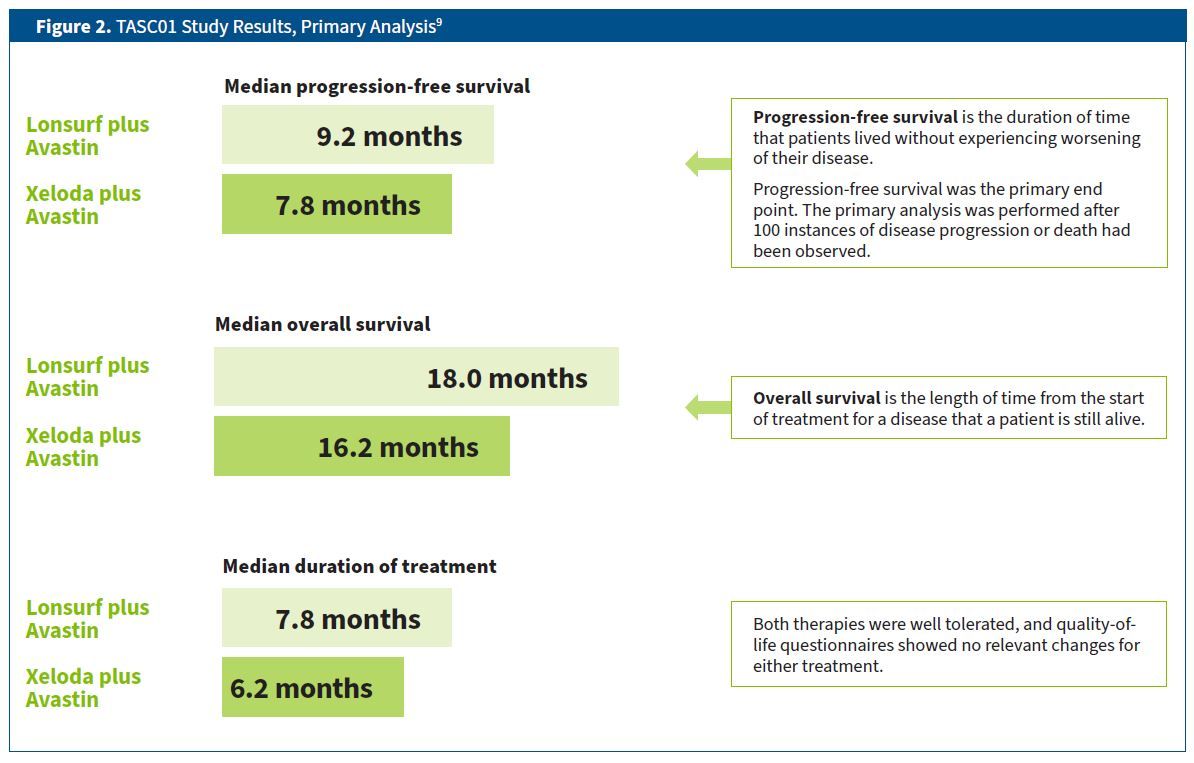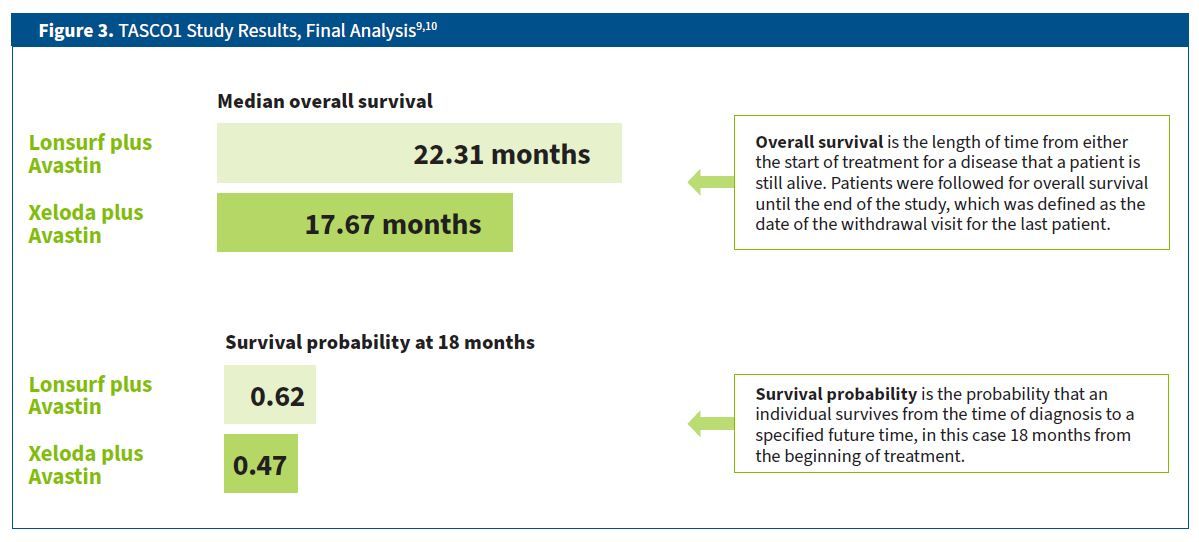Article
ASCO GI 2021: Phase 2 TASCO1 Trial
The Educated Patient®: Research Updates provides current clinical updates for different disease states. The following information is for educational purposes and is not medical advice.
FOR YOUR REFERENCE: What Are Clinical Trials?
Clinical trials determine whether a drug works in humans and if it is safe and effective. To find out whether a drug can be approved for use, the Food and Drug Administration (FDA) requires four phases of a clinical trial. The number of participants increases in each phase, starting from 20 to
80 people for a phase 1 trial to up to 3,000 for a phase 3 trial (Figure 1).1
- Phase 1: tests an experimental treatment on a small group of often healthy people to judge its safety and side effects and find the correct dosage.
- Phase 2: focuses on effectiveness and obtains preliminary data on whether the drug works in people who have a certain disease or condition.
- Phase 3: gathers more information about safety and effectiveness, studies different populations and dosages and examines use of the drug in combination with other drugs.
- Phase 4: occurs after FDA approval; monitors safety and effectiveness in large, diverse populations; and collects information on long-term side effects.

FOR YOUR REFERENCE: What Is Metastatic Colorectal Cancer?
Colorectal cancer starts in the colon or rectum and is often called colon cancer or rectal cancer depending on where it starts. Metastatic colon can-cer (also known as advanced colon cancer or stage 4 colon cancer) is can-cer that has spread beyond the colon to other organs. Colon cancer usually spreads to the liver because the blood supply from the colon is connected to the liver by a large blood vessel. However, it can also spread to the lining of the abdomen (peritoneum), ovaries, brain or other organs.2,3
Surgeons can remove colon and liver tumors during the same procedure to reduce pain and shorten recovery time. In some cases, it is necessary for the surgeon to perform a colostomy. The surgeon cuts the colon above the cancer and attaches the end to an opening in the belly. Waste is collected from the opening into a bag attached to the skin.4
Additional treatment options for patients with metastatic colon cancer include the following3,4:
- Chemotherapy before and after surgery.
- Targeted therapies, which attack specific genes and proteins in cancer cells.
- Immunotherapy, which uses the body’s immune system to attack cancer cells and is an option for people with colon cancer whose cancer cells have a specific genetic makeup.
- Interventional radiology treatments, such as ablation, which use highly focused energy to shrink or destroy tumors before or after surgery.
FOR YOUR REFERENCE: What Medications Were Investigated in the TASCO1 Trial?
Lonsurf (trifluridine/tipiracil), Avastin (bevacizumab) and Xeloda (capecitabine) are drugs approved by the FDA to treat metastatic colorectal cancer (mCRC).5-7 Lonsurf is approved for patients who have been previously treated with fluoropyrimidine-, oxaliplatin- and irinotecan-based chemotherapy regimens.5
Trifluridine’s absorption into the DNA of cancer cells allows it to prevent the cells from multiplying. Tipiracil stops trifluridine from being broken down during this process, thus enabling it to stop cancer cells from growing.6
Avastin works by blocking a protein that assists with the formation of tumor-feeding blood vessels.7 Xeloda interferes with DNA-producing enzymes, inhibiting new tumor growth and killing existing tumor cells.8
ASCO GI 2021: Phase 2 TASCO1 Trial
TASCO1 is a phase 2 clinical trial conducted across multiple centers in patients with untreated, unresectable (not removable by surgery) mCRC who were not eligible to receive oxaliplatin- or irinotecan-based chemotherapy medications. The study compared outcomes in patients who received Lonsurf plus Avastin with those receiving Xeloda plus Avastin. The primary end point was progression-free survival (PFS), the time frame following treatment when a patient’s disease does not worsen and death does not occur. Secondary end points were overall survival (OS), quality of life (QOL) and safety.9
One hundred fifty-three patients were randomly selected to receive either of the two medication regimens. One regimen consisted of Lonsurf given twice a day on days one through five and eight through 12, plus Avastin on days one and 15 of a 28-day cycle. The other regimen was Xeloda given twice a day from days one through 14, plus Avastin on the first day of a 21-day cycle.9,10
The cycles were repeated until disease progression, unacceptable toxicity, investigator’s/patient’s decision or death.9
Results
The results of the primary study analysis demonstrated that Lonsurf plus Avastin helped patients live longer without disease progression or death and was safe.9
The median duration of treatment in the Lonsurf plus Avastin group of the study was 7.8 months compared with 6.2 months in the Xeloda plus Avastin group. Patients who received the Lonsurf plus Avastin combination fared better regarding median PFS than those who received the Xeloda plus Avastin combination (9.2 months versus 7.8 months, respectively; Figure 2).9 Median OS was 18.0 months in the Lonsurf plus Avastin group compared with 16.2 months for the Xeloda plus Avastin group. There were no changes over time in QOL, based on questionnaires issued to patients.9

All patients were followed until the end of the study, defined as the date of withdrawal of the last patient. At the end of the study, 11 patients in the Lonsurf plus Avastin were still alive, as were
10 in the Xeloda plus Avastin group. Survival probability at 18 months was 62% in the Lonsurf plus Avastin group versus 47% in the Lonsurf plus Xeloda group (Figure 3).9,10 Median OS was 22.31 months in the Lonsurf plus Avastin group compared with 17.67 months for the Xeloda plus Avastin group.10

Both medication regimens were well tolerated by patients, with 18% in the Lonsurf plus Avastin group withdrawing because of adverse events that occurred during treatment and 14% of those in the Xeloda plus Avastin group doing the same. In the Lonsurf plus Avastin group, grade 3 (severe) or higher neutropenia (47% versus 5% in the Xeloda plus Avastin group), diarrhea (8% versus 1%, respectively) and other blood-related events were greater. Grade 3 or higher hand-foot syndrome was experienced by 12% of patients in the Xeloda plus Avastin group compared with none of the patients in the Lonsurf plus Avastin group.10
The TASCO1 study was the first to assess Lonsurf plus Avastin as a first-line treatment for unresectable mCRC. Investigators found that both treatment regimens produced safety profiles that mirrored data from earlier studies, with no new safety flags, and that QOL did not appear to suffer among patients. Based on the primary end point of PFS, the investigators concluded that treatment with Lonsurf plus Avastin is promising in patients who have unresectable mCRC and who are not candidates for intensive chemotherapy regimens.10
Not all patients qualify for certain clinical trials. If you are interested in enrolling in a trial, talk with your doctor about which treatment options would be most appropriate for you.
Not all patients qualify for certain clinical trials. If you are interested in enrolling in a trial, talk with your doctor about which treatment options would be most appropriate for you.
FOR YOUR REFERENCE: Glossary of Term
Ablation: a procedure to shrink a liver tumor by sending radio waves, chemicals, heat, or cold into the tumor
Adjuvant chemotherapy: chemotherapy given after the main treatment to reduce the chance of cancer coming back by destroying any remaining cancer cells
Adverse event: any undesirable experience associated with the use of a medical product in a patient
Alimentary canal: the passage along which food passes from the mouth to the anus
Anus: the opening at the end of the alimentary canal through which solid waste matter leaves the body
ASCO GI: American Society of Clinical Oncology Gastrointestinal Cancers Symposium
Chemotherapy: treatment that uses drugs to stop the growth of cancer cells either by killing the cells or by stopping them from dividing. These drugs are taken by mouth or injected and enter the bloodstream so they can help fight cancers that spread throughout the body. This can affect cancer cells and normal cells.
Colectomy: surgery to remove part of all of the colon
Colon: the longest part of the large intestine
Colonoscope: a flexible fiber-optic instrument inserted through the anus in order to examine the colon
Embolization: a procedure to shrink a liver tumor by cutting off its blood supply
End point: in clinical trials, an event or outcome that can be measured objectively to determine whether the intervention being studied is beneficial
Hand/foot syndrome: a side effect of some cancer treatments involving redness, swelling and pain on the palms of the hands and/or soles of the feet
Hepatic artery infusion: a method to deliver chemotherapy directly to a tumor in the liver via a pump
Immunotherapy: type of therapy that uses substances to stimulate or suppress the immune system to help the body fight cancer, infection and other diseases. Some types of immunotherapy only target certain cells of the immune system; others affect the immune system in a general way.
Large intestine: part of the digestive system; made up of the colon, rectum and anal canal and ends at the anus
Local excision: a standard treatment if the cancer is found on the inside surface of the rectum and has not spread into the wall of the rectum. The cancer and a small amount of surrounding healthy tissue are removed.
Locally advanced: The tumor may have grown to a specific size, the cancer may consist of multiple tumors and/or the cancer may have spread to adjacent lymph nodes, organs or tissue but has not yet spread to other parts of the body.
Lymph nodes: part of the lymphatic system in the body’s immune system; carry fluid containing white blood cells, which help fight infections
Metastatic: when the cancer travels from the original tumor and spreads to other parts of the body such as tissues or organs
Monoclonal antibody: a type of protein made in the laboratory that can identify substances in the body, including cancer cells. Monoclonal antibodies can be used alone or to carry drugs, toxins or radioactive substances directly to cancer cells.
Overall survival: the length of time from either the date of diagnosis or the start of treatment for a disease that a patient is still alive
Polyp: an abnormal growth that forms in the colon or rectum that can change into cancer over time; not all polyps become cancer
Polypectomy: a standard treatment when the cancer is found in a polyp; the polyp is often removed during a colonoscopy
Progression-free survival: the length of time during and after the treatment of a disease that a patient lives without disease worsening or death
Quality of life: the patient’s overall enjoyment of life. Many clinical trials assess the effects of cancer and its treatment on quality of life. These studies measure aspects of an individual’s sense of well-being and ability to carry out activities of daily living.
Radiation: type of cancer treatment that uses beams of intense energy to kill cancer cells
Rectum: the final 6 inches (15 centimeters) of the digestive system. Waste matter arrives here after going through the colon then is stored until it passes through the anus.
Recurrent cancer: cancer that has come back, usually after a period of time during which the cancer could not be detected; may recur in the same place or another place in the body
Safety profile: the chemistry, pharmacology, therapeutic effects and side effects of an administered drug or other substance
Side effect: any unfavorable or unintended disease, sign or symptom that occurs during the time a patient is receiving a medical treatment or procedure
Stage: the extent of cancer in the body. Staging is usually based on the size of the tumor, whether lymph nodes contain cancer and whether the cancer has spread from the original site to other parts of the body.
Survival probability: the probability that an individual survives from the time of diagnosis or a specified starting point to a specified future time
Targeted therapy: a cancer treatment that uses drugs to target specific aspects of the cancer cells
Toxicity: the extent to which something is poisonous or harmful
Tumor: an abnormal mass of tissue that forms when cells grow and divide more than they should or do not die when they should
Tumor: an abnormal mass of tissue that forms when cells grow and divide more than they should or do not die when they should
Unresectable: unable to be removed with surgery
References
- What are clinical trials and studies? National Institute on Aging. Accessed March 15, 2021. https://www.nia.nih.gov/health/what-are-clinical-trials-and-studies
- About colorectal cancer. American Cancer Society. Updated June 29, 2020. Accessed May 14, 2021. https://www.cancer.org/cancer/colon-rectal-cancer/about/what-is-colorectal-cancer.html
- Treatment for metastatic colon cancer. Memorial Sloan Kettering Cancer Center. Accessed May 14, 2021. https://www.mskcc.org/cancer-care/types/colon/treatment/metastases
- Treatment of colorectal cancer, by stage. American Cancer Society. Updated June 29, 2020. Accessed May 14, 2021. https://www.cancer.org/cancer/colon-rectal-cancer/treating/by-stage-colon.html
- Lonsurf prescribing information. Taiho Oncology Inc; 2019. Accessed May 14, 2021. https://www.lonsurf.com
- Raedler LA. Lonsurf (trifluridine plus tipiracil): a new oral treat-ment approved for patients with metastatic colorectal cancer. Am Health Drug Benefits. 2016;9(Spec Feature):97-100.
- Avastin (bevacizumab) information. Food and Drug Administration. Updated April 30, 2021. Accessed May 14, 2021. https://www.fda.gov/drugs/postmarket-drug-safety-information-patients-and-providers/avastin-bevacizumab-information
- Xeloda. European Medicines Agency. Updated March 26, 2021. Accessed May 14, 2021. https://www.ema.europa.eu/en/medi-cines/human/EPAR/xeloda
- Van Cutsem E, Danielewicz I, Saunders MP, et al. Trifluridine/tipiracil plus bevacizumab in patients with untreated metastatic colorectal cancer ineligible for intensive therapy: the randomized TASCO1 study. Ann Oncol. 2020;31(9):1160-1168. doi:10.1016/j.annonc.2020.05.024
- Van Cutsem E, Danielewicz I, Saunders MP, et al. Phase II study evaluating trifluridine/tipiracil + bevacizumab and capecitabine + bevacizumab in first-line unresectable metastatic colorectal cancer (mCRC) patients who are noneligible for intensive therapy (TASCO1): results of the final analysis on the overall survival. J Clin Oncol. 2021;39:3(suppl):14. doi:10.1200/JCO.2021.39.3_ suppl.14



